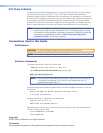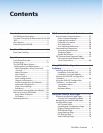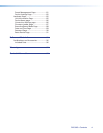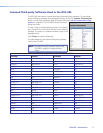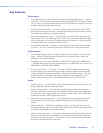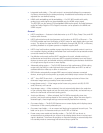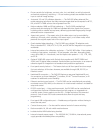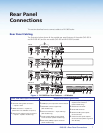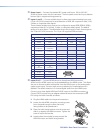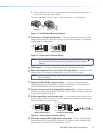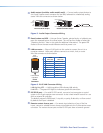
Key Features
Video Inputs
• Three HDMI inputs and two universal auto-detecting analog video inputs — The two
universal 15-pin HD inputs automatically detect incoming RGB, HD component video,
YUVi, S-video, or composite video signals. The DVS 605 allows for seamless switching
between HDMI and analog video sources.
• Auto input format detection — For the universal analog video inputs, the DVS 605
detects the incoming signal format, automatically reconfiguring the scaler to provide
the appropriate decoding and signal processing.
• Auto-switching between inputs — The DVS 605 can automatically switch between
input sources. With auto-switching, the DVS 605 can accommodate additional inputs
when connected to the outputs of a larger presentation switcher, or can be used for
unmanaged switching, or upstream matrix switcher.
• True seamless switching — Seamless cut and dissolve transition effects are available
for inputs 1 to 4. Input 5 features glitch-free switching with a fade through black.
Video Outputs
• Simultaneous scaled outputs for HDMI, HD-SDI, and analog RGB or HD component
video — HDMI and high resolution analog RGB or component video outputs are
available for driving two displays.
• Selectable output rates from 640x480 to 1920x1200, including HDTV 1080p/60 Hz
— Available output rates include computer video up to 1920x1200, HDTV rates up to
1080p/60Hz, and 2048x1080 (2k/60Hz).
• Picture-in-picture (PIP) — For inputs 1 to 4, the DVS 605 provides unrestricted two-
window display of standard definition and high resolution digital and analog video
sources. Multiple PIP presets are available, including side-by-side windows. The main
and PIP windows can be dynamically sized, positioned, and magnified. In audio
models, audio switching can be set to follow either the main or PIP window.
Audio
• Audio switching — The DVS 605 A and DVS 605 AD feature audio switching for ve
analog stereo balanced or unbalanced inputs.
• Output volume control — DVS 605 audio models provide master volume control.
Fixed and variable line level outputs are available, and each output can be balanced
or unbalanced. Stereo input signals can be output as dual mono. The DVS 605 audio
models also include a S/PDIF digital audio output.
• Audio input gain and attenuation — Gain or attenuation can be adjusted for each
analog audio input to eliminate noticeable differences when switching between
sources.
• Audio breakaway — Provides the capability to break an audio signal away from its
corresponding video signal and route to the audio outputs, allowing the analog audio
channels to be operated as a separate switcher.
• Audio switching transitions — A transition technique can be applied during switches
that lowers the audio of the switched-out source while simultaneously bringing up
the audio of the activated source. The duration of the audio crossfade matches the
duration of the video switching transition.
DVS 605 • Introduction 3





